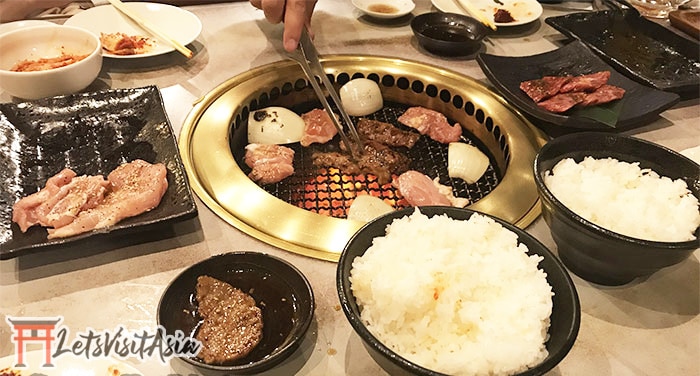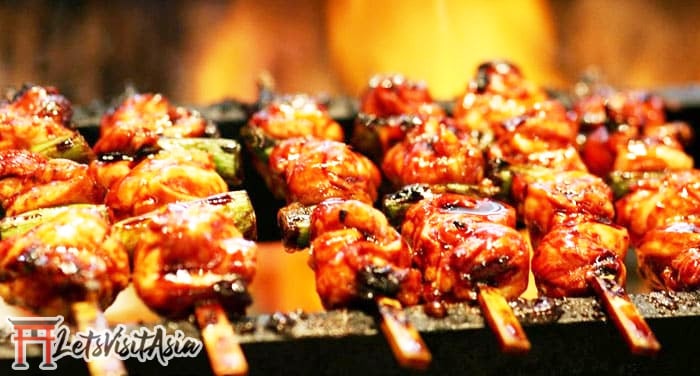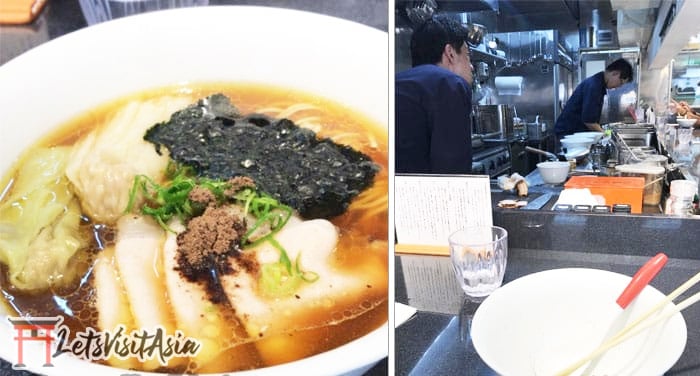Table of Contents
See the best Japanese foods to eat while you’re cutting or bulking in Japan…
There’s a high chance that you’re interested in traveling to Japan at some point in the future. It’s an amazing country with a unique culture that you won’t find anywhere else in the world.
The real reason why we love work visits to Japan is the food; the food over there is seriously tasty while still being fairly ‘healthy’ – there’s no reason to eat at McDonald’s when there’s Michelin starred ramen available for less than $15. (See our Best Ramen in Shinjuku article or our Tsuta Tokyo Review if you’re interested).
But we’ve had messages from our fans telling us that they’ve struggled to find high-protein foods & struggled to stay in shape while visiting Japan. And this isn’t too surprising if you can’t read Japanese menus, because you’ll find that Japanese meals are often filled with carbs (rice or noodles) while offering much smaller pieces of meat than in the USA and UK.
Ultimately, this often scares people who travel to Japan during a cut or wanting to maintain muscle mass (it’s no secret that many lifters in the USA & UK are still scared of carbs while trying to lose unwanted pounds, and of course, protein is vital in maintaining and increasing muscle mass).
Don’t worry though, because here at LetsVisitAsia we’ve got your back. We’ve made a top 5 of the best foods (and meals) that you can find in Japan while you’re trying to gain muscle or get involved with the Japanese weight loss secrets and techniques.
Take a look:
Popular Posts:
- Immune Support for Traveling
- Performance Lab Sleep Review
- Performance Lab Multivitamin Review
- Best Gyms in Japan for Tourists
- Japan Eating Habits
- Best Belly Fat Burner
Top 5 Foods for Japanese Bodybuilding
1. Yakiniku (Best Overall Japanese Food For Cutting & Bulking)

This is one of my favorite meals in Japan. This literally translates to ‘Cook Meat’, as it basically consists of thinly sliced beef, other meats, and vegetables that you grill yourself at your table in restaurants.
You can actually find Yakiniku restaurants in the USA and UK, but it’s more ‘Korean BBQ’ style over in these countries. In Japan, the marinade of the meat is more suited for Japan (which should seem quite obvious), and we think it’s tastier for this reason.
Anyway, we’re making Yakiniku our number 1 recommendation, because it’s great for lifters that want to cut carbs and lose weight, and also for those wanting to maintain a high-protein diet while over in Japan.
BBQing food really is one of life’s simple pleasures, and it’s something humans have been doing since the caveman times (probably). Being able to BBQ high-quality Wagyu beef at your table is incredible, and it’ll fit into your diet regardless of your goals.
2. Green Tea & Matcha (Best Japanese Secret For Weight Loss)

We thought long and hard about where to place this, and you could argue that it could be at the number 1 spot. However, Green Tea and Matcha are arguably more beneficial to those on a cut and aiming to lose body fat, rather than for those wanting to bulk up or maintain muscle mass.
Why? Because Green Tea and Matcha are known to be capable of to boosting your metabolism and promote fat loss; in short, this is due to both nutrients containing high amounts of catechins [1].
Green Tea
If you’re in the USA or UK, then Green Tea can be hard to consume throughout the day. Your best option in these countries is to keep boiling the kettle and refilling your cup with tea-bags of green tea.
However, the good news is that it’s much easier to consume Green Tea regularly throughout your day. This is because you can find cold Green Tea bottles in vending machines, which is one of our favorite things about visiting Japan – it’s something that needs to become available in the USA and UK! Not only that, cold Green Tea is often available for free in most restaurants too.
In fact, many Japanese people can be seen choosing cold Green Tea bottles over Coca-Cola and other soda; this might actually help explain why the Japanese diet is one of the healthiest in the world.
Matcha
While Green Tea is still available in the USA & UK, good-quality Matcha is something that’s harder to find outside of Asia.
In Japan though, Matcha is in abundance. We’re not kidding either. You can find Matcha tea in most cafes, and almost every ice-cream bar offers Matcha flavored ice-cream. In fact, there are even Matcha flavored Kit Kats being sold in Japan!
Anyway, if you’re not into nutrition, you might be wondering why we’re going crazy for Matcha. Well, this is because Matcha contains up to 137 times the amount of catechins that is found in Green Tea (and catechins are the main reason why Green Tea is capable of promoting fat loss) [2].
For this reason, if you’re wanting to kickstart your metabolism and stay lean during a visit to Japan, then grab cold Green Tea bottles from vending machines and indulge in hot Matcha drinks in cafes. Limit the amount of Matcha flavored Kit Kats you eat for obvious reasons though…
3. Yakitori (Best Japanese Food For Non-Red Meat Eaters)

We mentioned Yakiniku as our number 1 recommendation while in Japan. Yakitori is very similar, but will be better for those wanting to limit the amount of red meat they eat; this is because Yakitori restaurants offer solely BBQ’d chicken on sticks.
We all know how Americans love food on sticks, so this is something that’s definitely going to be a favorite for most westerners visiting Japan. It’s seriously tasty and again, we’ll repeat that it comes on sticks – that’s right.
You can go for the lean pieces of chicken (breast) on sticks, BBQ’d in nice ‘teriyaki’ style marinades. Or if you’re going for more of a ‘cheat meal’, then you can go for the BBQ’d chicken skin on sticks instead – either way, you’ll be getting a tasty treat.
As you can see, Yakitori restaurants will suit anyone, regardless of whether you’re cutting, maintaining muscle mass, or bulking. So get involved – you won’t regret it.
4. Natto (Best Japanese Food For Vegetarians)

There’s a lot of arguments about which foods can be considered as ‘superfoods’ in the USA and UK. But one thing that’s incredibly beneficial and really only seen in Japan is Natto; this is a form of fermented soy-beans that contain bucket-loads of vitamins and minerals.
But the main benefits of Natto that we’ll highlight is that it’s a high-protein source for vegetarians and that it’s a great source of Vitamin K2; Natto is believed to contain up to 31g protein per cup and can help deliver around 775mg Vitamin K2 per 100g.
For this reason, we always make sure to add Natto to our diet while visiting Japan. But be warned though, Natto has a distinct smell that many consider being ‘bad’; we found that it shocks you at first, but becomes bearable after eating it a few times. So don’t let the potentially ‘bad smell; put you off eating Natto – you’ll be glad to hear that it’s nowhere near as ‘smelly’ as durian, so give it a go!
5. Sashimi (Best Seafood Japanese Food For Bodybuilding)

Sashimi is basically dishes that are made-up from thin slices of raw fish. There are many varieties of fish to choose from including; salmon, tuna, mackerel, yellowtail, and sea urchin.
In terms of nutritional value, if you go for leaner pieces of fish, then Sashimi probably tops this list. But we know how many of you in the USA & UK react to raw fish – not everyone likes it. That’s why we placed BBQ’d meat towards the top of this list.
However, if you are willing to try Sashimi, then it might even become your favorite food in Japan. It’s lean, high-protein, and fits into your diet while you’re wanting to both cut body fat bulk-up by reaching your protein macros.
Just one thing though; there are many fatty pieces of tuna and other fish that’s found in Sashimi, so be sure to avoid those if you’re following a low-fat diet. Stick to the lean-cuts if that’s the case (you’ll be able to see which pieces clearly have more fat on them).
Bonus: Ramen Noodles for Bodybuilding

A bowl of ramen from the right place in Japan will change your life. We never thought that a bowl of meat-stock, noodles, and meat could be so tasty, as it’s something that’s not quite been perfected over in the USA or UK.
In Japan though, many ‘Ramen Masters’ have spent years perfecting their dishes. This is clearly displayed by the fact that Japan had the first Michelin starred Ramen bar, and you can eat there (at the restaurant called ‘Tsuta’) for under $15 – an absolute bargain. We ate there, and while we lined up for about 30 minutes, it was definitely worth the wait.
The bad news is that Ramen is quite calorie dense, so you might want to limit how much you eat if you’re on a calorie-deficit (unless you’re willing to go for a run and burn some calories so Ramen fits into your diet). But if you’re on a bulk and have a lot of calories to play with every day, then Ramen is going to be one of your favorite things in Japan – no doubt about it.
Other Japanese Weight Loss Secrets & Tips
We’ve shown you the best 5 Japanese foods for bodybuilding above. And while changing your physique or figure depends largely on your diet, there are many changes that you can make to your lifestyle to help you stay on-track for your fitness goals – even on holiday or a business trip.
So now we’ll give you some more tips on how to keep fit and healthy in Japan.
Walking Tours

Walking tours are a great way to see the best sights around Japan. They’re usually led by experienced tour guides that’ll know the hidden spots and places that you probably wouldn’t see otherwise.
You can find walking tours everywhere in Japan, but our favorite places to go are:
- Nikko
- Hakone
- Mount Fuji (and the 5 surrounding lakes)
- Kyoto
- Nara
If you’re into checking your steps every day with a FitBit or on Apple Health (on your iPhone or iWatch), then you’ll really enjoy these walkings tours. On a typical tour, we recorded around 20,000 steps per day; this equals around 1,000kcal burned, according to many fitness experts.
Don’t worry if you don’t fancy walking literally everywhere either. We went on tours where you’d be driven to many locations (on an air-conditioned coach), but then walk around the temples, Japanese gardens, and landmarks once you arrive – on these tours, you would still record at least 10,000 steps per day while seeing and traveling more.
Remember though, if you’re trying to maintain muscle mass or bulk-up, then you need to eat more protein and calories to stay at or above your TDEE (so you don’t start losing valuable gains). If you’re cutting, then you’ll enjoy burning calories – but as you’ll know, it’ll still be important to reach your protein macros per day.
Note: Feel free to comment on this article and recommend your favorite places that we can add to our list of best walking tours.
Gold’s Gyms

As we mentioned, weight-lifting still hasn’t really taken off in Japan. It’s still fairly rare to find stacked-Japanese people walking around (definitely compared to the USA and UK).
However, you don’t have to worry about finding good quality gyms while you’re travelling Japan; this is because you can find many Gold’s Gyms scattered across Tokyo (and the rest of Japan) – although they are quite expensive per session, you can’t put a price on maintaining your gains, right?!
Ultimately, if you’re addicted to lifting iron and want to let off some steam while in Japan, finding a Gold’s Gym is probably your best option. We’ll mention that there are other gyms available, but Gold’s Gym had the best equipment that we saw (we didn’t see everywhere though, so feel free to comment and provide some recommendations).
Onsen

Just in case you’re wondering, Onsen’s are traditional Japanese baths that are filled with natural water from hot springs. You’ll find a lot of these in Hakone, and we enjoy sitting in these instead of sweating in saunas.
Now, sitting in a sauna or Onsen isn’t going to make you into a shredded beast. But if you regularly add a sauna session to your lifestyle for whatever reason, then indulging in Japanese culture and choosing an Onsen while in Japan isn’t a bad idea – it’s supposed to be really beneficial for your skin, in case any of you brah’s or females like to take care of your skin are reading this.
Just a quick note before you go to an Onsen though; everyone will be completely naked in these hot spring baths, without any swimwear, so don’t be surprised at this…
Conclusion: Best Foods for Japanese Bodybuilding
There’s really no reason why you should go on holiday and come back completely out of shape (not that we’re saying there’s anything wrong with it either…). But we know that many of you reading this article have spent years to create a physique to be proud of, and are prepared to work hard to maintain that; this is the main reason why we chose to write this article.
Ultimately, going to Japan without doing your research can be scary. Not everywhere provides English menus, and you might be surprised by how few Japanese locals can speak English (if you visit Japan expecting everyone to be able to speak English).
References
-
AB Hodgson. The Effect of Green Tea Extract on Fat Oxidation at Rest and during Exercise: Evidence of Efficacy and Proposed Mechanisms. Adv Nutr. 2013 Mar; 4(2): 129–140.
-
DJ Weiss. Determination of catechins in matcha green tea by micellar electrokinetic chromatography. J Chromatogr A. 2003 Sep 5;1011(1-2):173-80.

